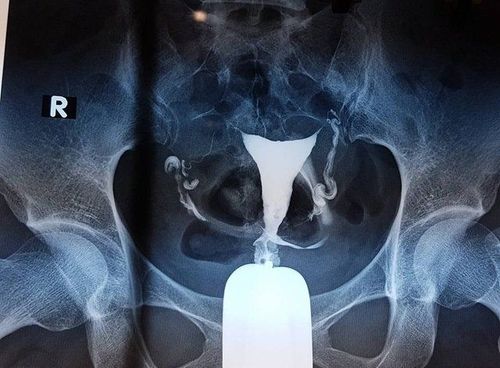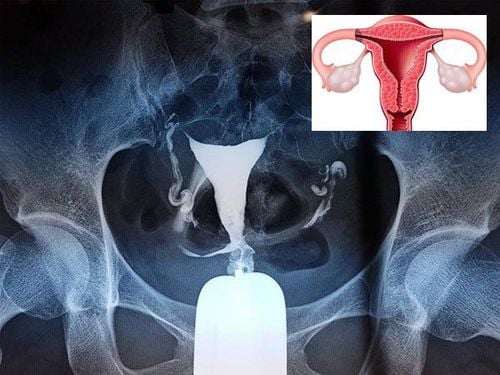This is an automatically translated article.
The article is professionally consulted by Master, Doctor Lam Thi Kim Chi - Department of Diagnostic Imaging - Vinmec International General Hospital Da Nang.X-ray of the uterus and fallopian tubes is a technique to help examine and evaluate a woman's uterus when they have difficulty conceiving a child. The diagnosis and assessment of the actual condition of the uterus and fallopian tubes play an important role in identifying the causes and providing treatment for infertility diseases.
1. What is a hysterosalpingogram?
Currently, it is not uncommon for patients of childbearing age to have difficulty conceiving a child. The cause of infertility can be male, female, or unknown. Particularly for women, the cause of blocked fallopian tubes, blocked fallopian tubes accounts for the highest percentage.
Hysterosalpingogram (HSG) is a special test to check the patency of the fallopian tubes and uterus, helping to diagnose primary and secondary infertility due to tubal occlusion.
The technique of taking X-ray of the uterus and fallopian tubes has appeared for a long time and is used quite often for women who are trying to conceive and are infertile (infertile).
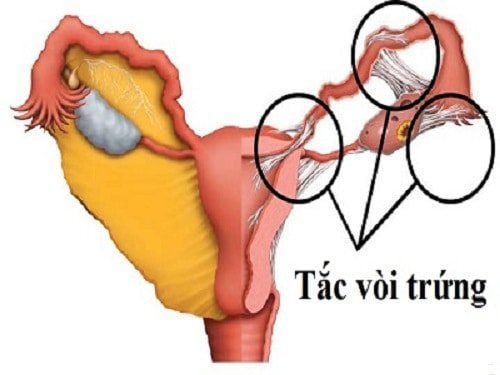
2. Indications and contraindications
2.1 Indication case
X-ray of the uterus and fallopian tubes is usually indicated for the following purposes:
Diagnosis of abnormal masses inside and outside the uterus (uterine fibroids, uterine adhesions, endometrial polyps, congenital malformations). or uterine tumour). Diagnosis of genital malformations (if any). Evaluation of tubal circulation during infertility treatment. Evaluation of endometrial condition, prevention of endometriosis. Examination and evaluation of the intrauterine contraceptive device. Checking the status of the fallopian tubes after tubal surgery, tubal ligation... In which, the most valuable indication of a hysterosalpingogram is to help diagnose primary and secondary infertility due to tubal occlusion. egg. Many patients have difficulty in getting pregnant or have had problems during pregnancy such as miscarriage, ectopic pregnancy ... then the doctor can prescribe this technique. An X-ray of the uterus and fallopian tubes can help diagnose the cause of infertility.

2.2 Contraindications
Hysterosalpingography technique is not indicated if the patient is pregnant, has an active genital tract infection, has genital bleeding (menstrual or vaginal bleeding), has sexually transmitted diseases. Patients who are allergic to iodinated contrast media should also inform their doctor in advance for a suitable treatment plan.
In cases of contraindications, it may be possible to consider using other imaging techniques (without the need for intrauterine infiltration) that still have the same value as: ultrasound, magnetic resonance imaging, CT scan.

3. Uterine and fallopian tube X-ray procedure
3.1 Preparation before shooting
The most suitable time to take an X-ray of the uterus and fallopian tubes is 3-7 days after menstruation (equivalent to day 8-12 of the menstrual cycle). This is the best time to get a good look at the uterus and fallopian tubes and avoid the effects of X-rays if you miss an early pregnancy.
When preparing for an X-ray of the uterus and fallopian tubes, the patient needs to inform the doctor about the condition of the body such as:
The patient is pregnant or suspected of being pregnant. Pelvic infection or sexually transmitted diseases such as gonorrhea, Chlamydia, genital warts ... Are being treated for diabetes or have a history of diabetes or kidney disease. The team that performs an X-ray of the uterus and fallopian tubes usually includes:
Professional radiology technicians. Gynecologists and nurses can help. About 5 days - 1 week before the scan, the patient will have an obstetric and gynecological examination to rule out advanced genital infections, take prophylactic antibiotics 2 days before the HSG scan, and be advised to abstain from sex. before shooting. It is advisable to ensure that the patient does not use gastrointestinal contrast for 5-7 days before the scan. Before the procedure, the patient may be given a sedative or Ibuprofen (eg, Advil) to relax and relax the uterine muscles, making the X-ray process easier.

The radiologist advises and explains to the patient the possible risks during the examination and guides the patient to sign a commitment before entering the imaging room.
In addition, the patient should urinate and empty the bladder before the procedure.
3.2 X-ray technique of the uterus and fallopian tubes
The patient lies supine, along the table, with the head turned to the front of the machine. Encourage, reassure and explain to the patient during the scan. Cover areas that do not need to be scanned (chest, thyroid...). Instruct the patient to stay still during the scan
Before the hysterosalpingogram, the doctor will place a flexible tube (small catheter) to pass the contrast material into the patient's uterus. Because the uterus and fallopian tubes are connected, the dye will flow into the fallopian tubes, thereby showing clearly whether the uterus or fallopian tubes are damaged, infected, or blocked.
If the fallopian tube is open, the contrast material will flow through it to enter the abdomen, where it will be absorbed naturally by the body. If the fallopian tubes are blocked, the contrast medium will not be able to pass through.
During the X-ray of the uterus and fallopian tubes, the patient may feel some discomfort and slight cramping when the doctor injects contrast material into the uterus and this feeling will not last. Patients are encouraged to relax their body so that the scan can take place more easily and quickly. Estimated total time to perform this procedure usually takes 30-45 minutes.
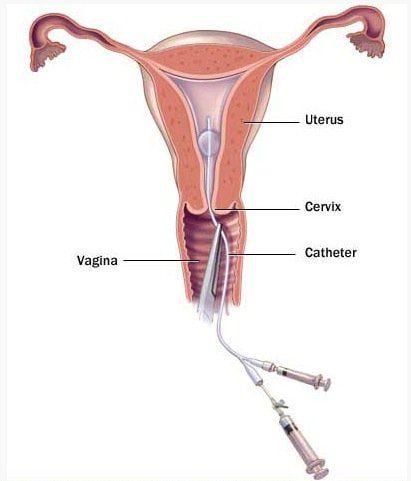
3.3 Post-procedure care
After the hysterosalpingogram, the patient may feel mild lower abdominal pain due to the reaction of the peritoneal cavity to the contrast medium. After the procedure, the doctor will ask the patient to stay for about 30 minutes to make sure his condition is stable.
When you go home, some of the contrast material will flow out of the patient's vagina, leading to some patients having vaginal bleeding for the first few days, but the amount is not much and is not dangerous. However, tell your doctor immediately if you notice the following signs:
Heavy vaginal bleeding (wetting more than 1 tampon in 1 hour, bleeding lasting more than 3-4 days). Abdominal pain or severe cramping. Fever. Nausea, vomiting. Fainting.
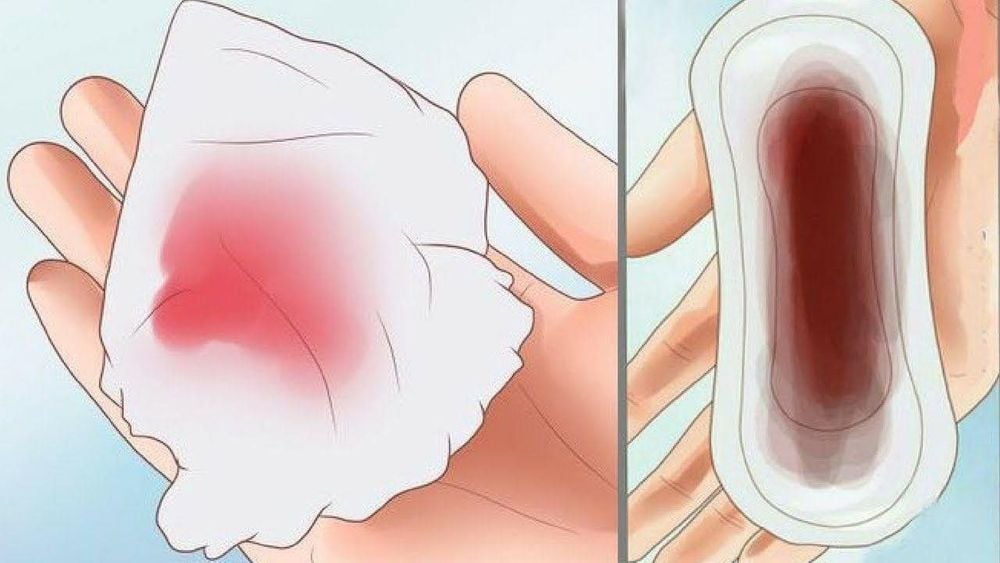
Hysteroscopy - uterine tube is an effective support method in the process of identifying and treating infertility and infertility. If you are having fertility problems, you can go to Vinmec International General Hospital to be examined and consulted by doctors from the Department of Obstetrics and Gynecology.
Vinmec International General Hospital ensures professional quality with a team of leading medical doctors, a system of modern equipment and technology, but also stands out with comprehensive and professional medical examination, consultation and treatment services. ; civilized, polite, safe and sterile medical examination and treatment space. Customers when choosing to perform tests here can be completely assured of the accuracy of test results.
Please dial HOTLINE for more information or register for an appointment HERE. Download MyVinmec app to make appointments faster and to manage your bookings easily.
Recommended videos:







